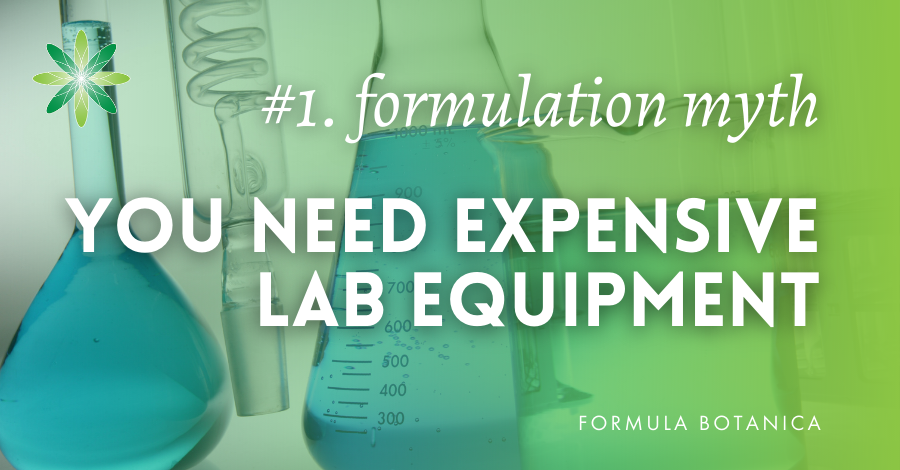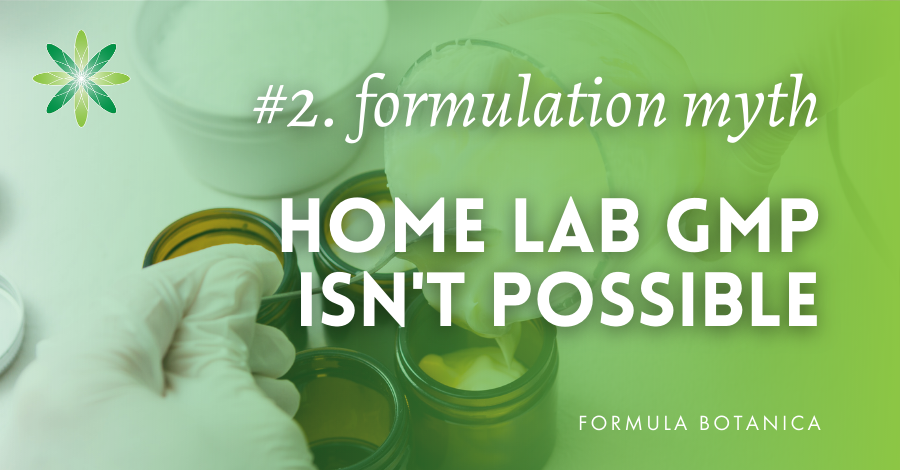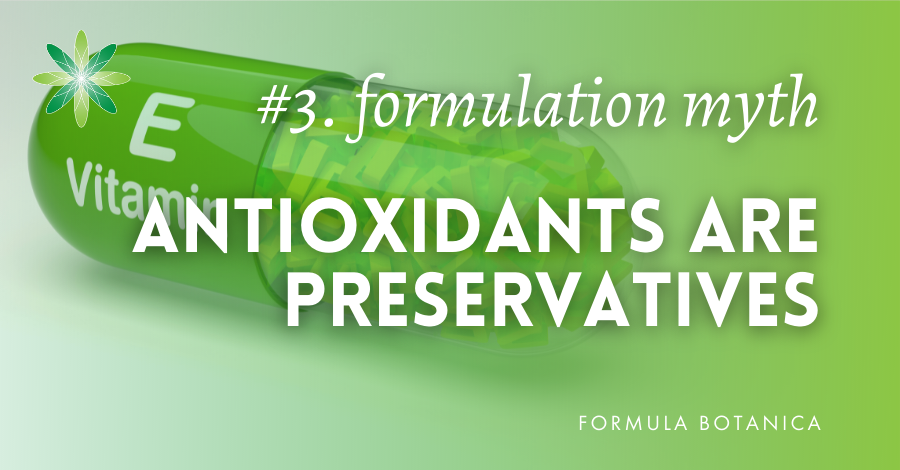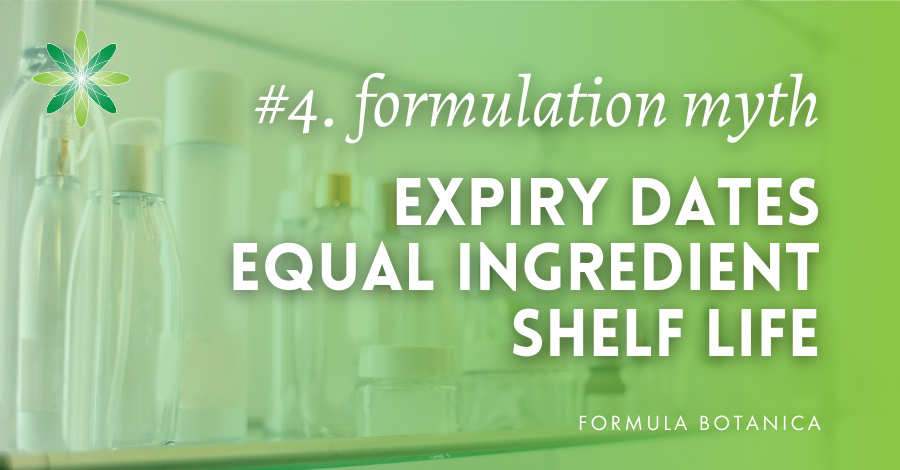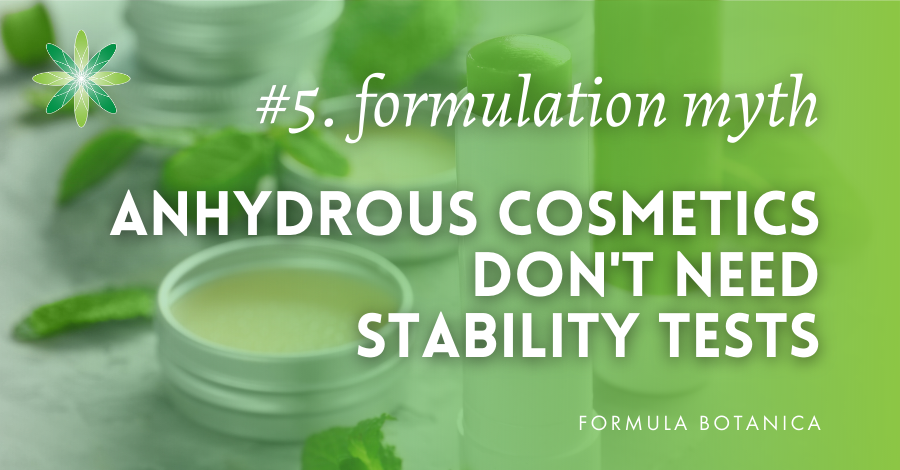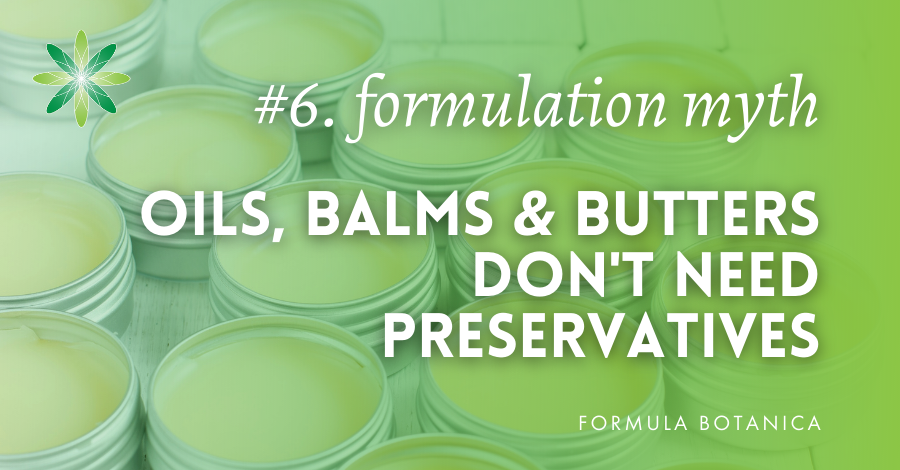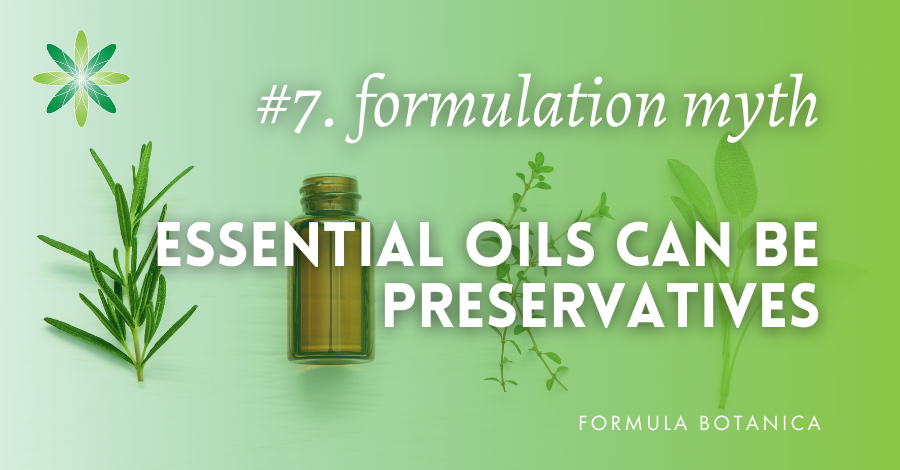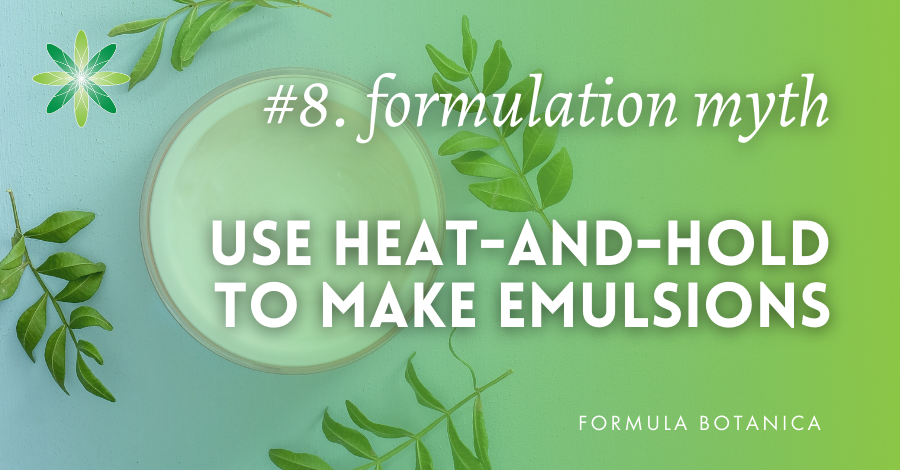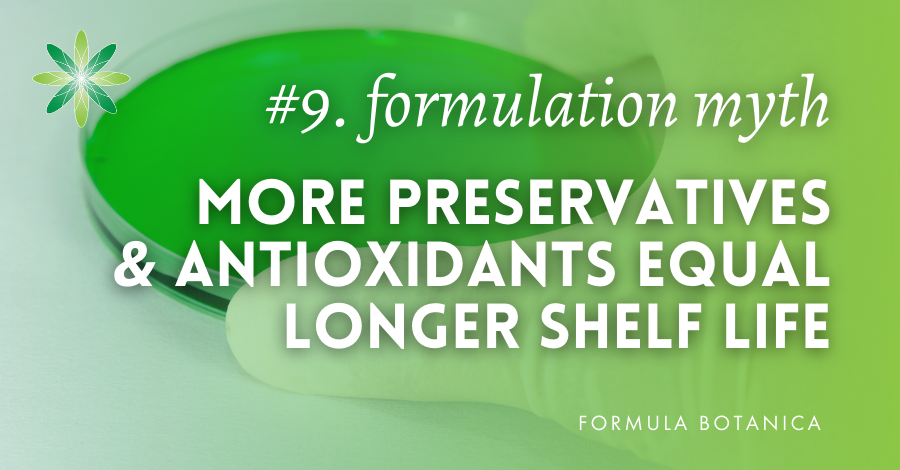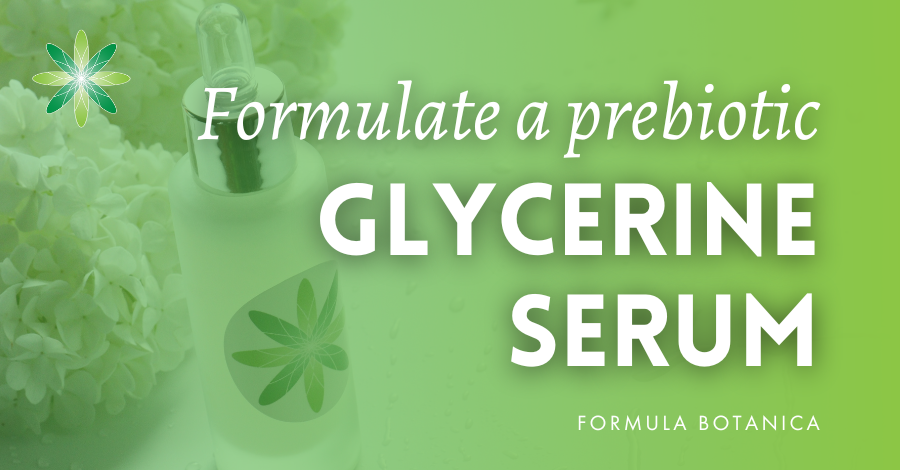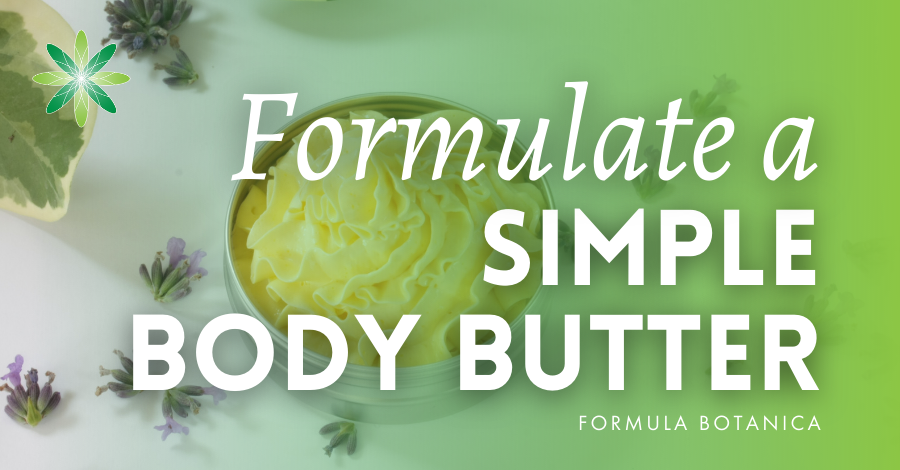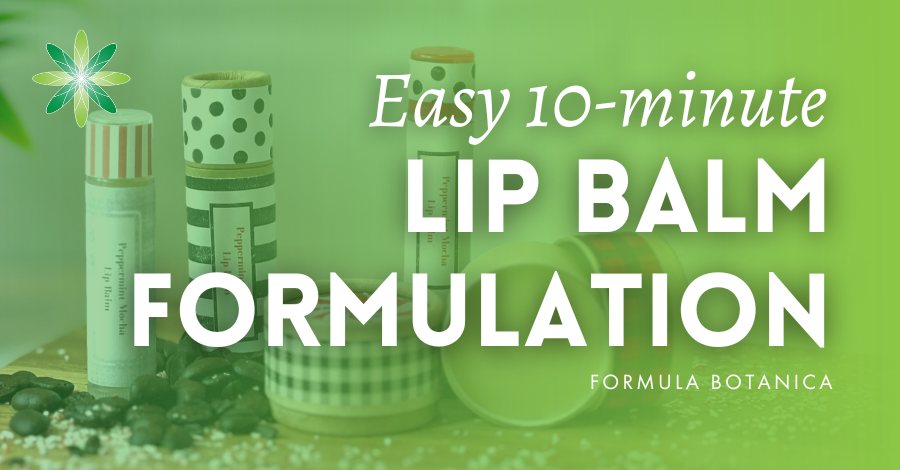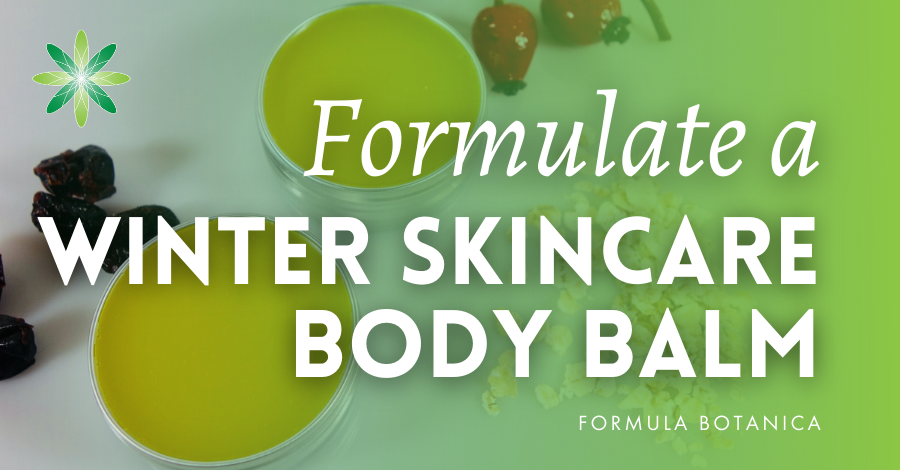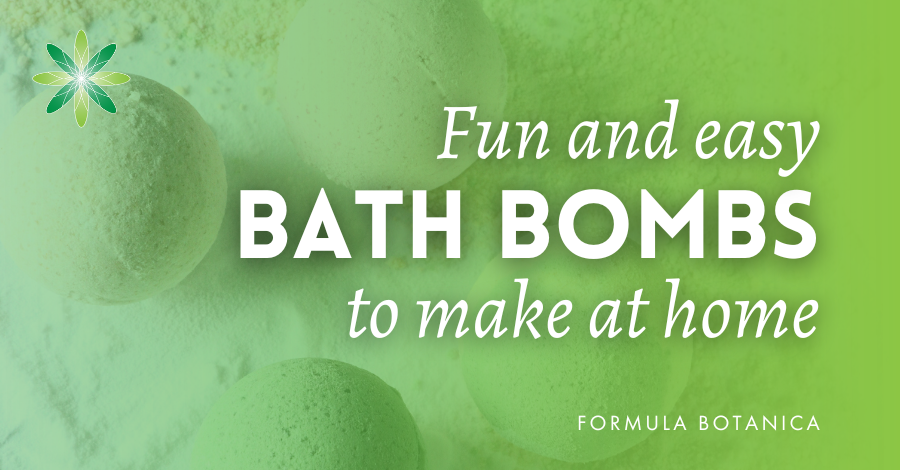Whether you are new to natural formulation or a more advanced formulator, you are likely to spend time browsing online to get inspiration and come across advice from both industry experts and DIY beauty pundits on social media. Sometimes, myths and misconceptions about natural formulation circulate and end up as taken for granted when the truth of the matter lies elsewhere.
For this post, we asked our in-house education and tutor teams to compile their top formulation myths. We are sure you will be familiar with some. We examine 10 common misconceptions, explain how they are likely to have arisen and give you the background to debunk them.
Top 10 myths of natural formulation
1. You need a lot of expensive equipment to formulate skincare
This is one of the most frequently-asked questions we receive at Formula Botanica, and one we answer with a clear ‘no’. For decades, mainstream beauty industry commercials have featured people in lab coats. But, this does not mean that the indie beauty formulator needs an expensive, fully-equipped lab to create safe, efficacious cosmetics to sell.
The beginner formulator working from home, often on a kitchen surface to start with, can learn the core skills of natural formulation with about five to 10 pieces of readily-available equipment. Many items you need are familiar kitchen utensils, such as mini whisks, stainless steel bowls and pans, spoons, glass bowls and a heat source like a hotplate – or your regular hob when you start out.
We recommend you buy a new set of the basic equipment and do not use everyday kitchen tools to ensure you keep things hygienic. We also urge you to learn and follow good manufacturing practice (GMP). The articles and videos linked below set out all you need to know about setting up a home formulation lab cost effectively and starting to formulate successfully with a just a few items of equipment. See myth #2 for more on GMP.
Top 6 lab tools every formulator needs
Beginner’s guide to setting up a home formulation lab
Starting a cosmetics business at home
How to set up your artisan skincare lab
A day in the life of a natural formulator
2. You cannot formulate to GMP from home
Good manufacturing practice (GMP) is a checklist of guidelines governing the health, safety and processes and procedures required in manufacturing. There are specific requirements that need to be adhered to in the manufacture of cosmetics that are intended for sale, and national jurisdictions will have their own regulations to comply with too.
While this may seem daunting to the home formulator, it is perfectly possible to adhere to GMP in your home lab or working space. Most of the guidelines are common sense, such as ensuring adequate lighting and ventilation, keeping expired and waste products separate from new stocks, wearing suitable personal protective equipment, and keeping detailed documentation on each batch you formulate and so on.
We advise our new students to get familiar with GMP as early as possible in their studies. So by the time they are thinking of selling their cosmetics, they are already in the routine of working seamlessly to GMP.
In some countries, it is not permitted to manufacture cosmetics at home, but this is a different issue from that of adhering to GMP. Check the law in your country if you wish to start a cosmetics business at home. You may need a cosmetic chemist to formulate your products in an approved lab, but this does not mean you cannot create and test formulations and plan your range yourself from home. These articles help clarify what GMP involves and other aspects to consider when making cosmetics at home.
Do you need a license to sell skincare products?
Beginner’s guide to setting up a home formulation lab
8 point to know before making homemade skincare
How to handle an FDA inspection
3. Antioxidants are preservatives
The definition of ‘to preserve’ is to keep something as it is, especially in order to prevent it from decaying or being damaged or destroyed. To some extent, antioxidants do this. They are a group of chemicals capable of slowing down oxidisation which can cause the degradation – the rancidity, colour and odour change and instability – of a cosmetic product. You will have heard about antioxidants too as active cosmetic ingredients. In brief, they act to help neutralise free radicals that cause oxidative stress in the skin that can give rise to visible signs of premature ageing.
Botanical oils are prone to oxidisation in varying degrees, depending on their composition and fatty acid profiles. It is common to find vitamin E added to emulsions and anhydrous formulations on account of its antioxidant properties. Some other common botanical antioxidants used in cosmetics are derived from pomegranates, grapes and green tea.
While antioxidants help maintain a cosmetic in its desired original state, they do not act as and must not be confused with preservatives, which are a separate category of cosmetic ingredients serving a different purpose.
Preservatives are designed to prevent a product’s microbial contamination through the growth of bacteria, mould and yeasts. Antioxidants do not prevent the growth of these microbial contaminants that can be harmful and potentially life endangering. Water-based and water-containing cosmetics and even some anhydrous and dry, powdered cosmetics require an efficacious preservative system that must undergo challenge testing before the product can be certified safe for the market and consumer use.
At Formula Botanica, we stress the importance of preserving your cosmetic formulations. There has been much fear-mongering around the use of preservatives, particularly parabens, in cosmetics which has led some formulators to omit preservatives altogether, even plant-derived ones.
These links explain further the critical role of preservatives, list some effective natural preservatives and guide you on choosing the right one. If you are making cosmetics for sale and wish to be confident in using natural preservatives, pre-enrol for our Certificate in Natural Cosmetic Preservation. See also our Formulator’s Guide to Antioxidants which details the science of how they work in cosmetics to protect both our skin and our products.
The formulator’s guide to antioxidants in cosmetics
Everything you want to know about natural preservatives
16-point checklist: choosing a natural preservative for skincare
Podcast 63: Parabenoia: how parabens started the indie beauty movement
Are your cosmetics killing you?
4. A cosmetic’s expiry date is that of its ingredient with the shortest shelf life
No, not necessarily; it depends. The only way to be sure of the shelf life of a cosmetic product you have formulated is to have it stability tested by an independent cosmetic safety assessor. Not all cosmetics need to have professional third-party assessors determine their shelf life, but you need to check the cosmetic regulations in your country or region. There are also plenty of stability tests you can perform yourself in your artisan lab using readily-available equipment, such as freezers and incubators.
When making cosmetics as trials, you can set a benchmark for their shelf life based on the ingredient in your formulation that has the shortest shelf life. However, at best, this is only a rule of thumb. When ingredients combine in a formulation, they react and perform differently from how they would as single, standalone ingredients. So, do not rely on a vague benchmark.
Cosmetic packaging regulations require the shelf life of the product to be marked clearly on the outer and inner packaging of a cosmetic product. Here is some suggested further reading on stability testing:
3 reasons all skincare formulations undergo stability testing
4 signs of a cosmetic product’s instability
How to sell homemade skincare (includes a section on cosmetic regulations and testing)
See also our Certificate in Cosmetic Stability Testing (including 20 tests you can perform yourself).
5. You don’t need to stability test anhydrous products
First, let’s clarify: stability testing is not the same as challenge testing which determines the efficacy of a preservative system in a cosmetic product. Stability testing assesses the optimal shelf life of a product, irrespective of whether is it water based or anhydrous.
Anhydrous products, such as those with oils, butters and waxes, do not need challenge testing as they do not contain water which acts as the ideal environment for microbes to take hold. A body balm containing only oils and butters can split, be grainy, become rancid and discolour over time. Stability tests will determine how long anhydrous products maintain their original and intended state.
An oil-only product may for instance be composed of mainly jojoba and fractionated coconut oils, which are known for their long stability of between three to five years; or it may contain short shelf life, less stable oils such as borage, evening primrose or rosehip. As you can see, stability testing anhydrous products can pinpoint their optimal shelf lives. See the links above in #4 to find out more about stability testing.
6. Anhydrous products don’t need preservatives
Again, this is not entirely true. You probably know that a cosmetic composed of water or water containing is susceptible to microbial contamination and therefore requires a preservative system in order to be safe for consumer use. There are some exceptions such as when a product has a very high alcohol content as you find in some hand sanitisers, which are rendered self preserving, or when there is a minute amount of water present, as is the case in our formulation for a solid shampoo bar.
The solid shampoo bar is a good example of an anhydrous or virtually waterless product that might still need a preservative. Anhydrous cosmetics that are likely to come into contact with water, such as the user’s wet or damp fingers or when left open to the air in a steamy bathroom, may become contaminated. The water droplets within or on top of the product can be the breeding ground of microbes.
You need to think carefully about the intended and likely use of a cosmetic product you formulate as well as assessing its water content or lack of water. If in doubt, err on the side of caution and add a preservative. You will find plenty of suggestions for natural preservatives in this article:
Everything you ever wanted to know about natural preservatives
7. Essential oils can be used as preservatives
Essential oils do not act as complete preservative systems on their own to give a natural cosmetic the required level of safety for consumer use. Most consumer cosmetics require broad spectrum preservatives to protect against contamination from bacteria, mould and yeasts.
Some essential oils, such as tea tree (Melaleuca alternifolia), thyme (Thymus vulgaris), lemon grass (Cymbopogon citratus), oregano (Origanum vulgare), and rosemary (Rosmarinus officinalis), do have chemical constituents offering some level of antimicrobial action. Essential oils like these and others are increasingly the focus of research into natural preservatives, and are being investigated as components of preservative systems.
There is much research into essential oils as cosmetic preservatives, or used in combination with mainstream preservative systems, on account of the negative connotations of synthetic preservatives such as parabens. However, so far, most research has shown the studied essential oils to be below the required test threshold to perform as standalone preservatives at the levels permitted within cosmetics. Remember, certain essential oils contain allergens which restrict their level of use in cosmetics.
Essential oil science is complex and we advise the indie beauty formulator to use commercial, well documented and tested natural preservatives to provide full, broad spectrum preservation of their products. By all means include essential oils in your formulations but not as perservatives.
8. It’s best to use the heat and hold method
The heat-and-hold method of emulsion making is one of the oldest and most widespread myths about cosmetic manufacture there is. It proposes that you heat to the required temperature – usually around 70-75°C – both the oil and water phases of your emulsion and then hold them at that temperature for around 20 to 30 minutes before blending the phases together and homogenising the emulsion. There is no logic nor scientific reasoning for doing so, and in fact, more harm can be done to some ingredients, such as heat-sensitive oils and hydrosols, in the process.
We tackled this myth several years ago in an extensive blog post linked below and yet it still crops up as an FAQ in our community and circulates online. Our article knocks on the head the key six reasons proponents of this method list for using it. If you’ve heard of the heat-and-hold method and were tempted to use it, do read on for the sound science that debunks it:
9. A higher amount of preservative or antioxidant means a better product shelf life
First, there are two issues muddled in this statement. We explained the difference between preservatives and antioxidants above, and so you will know that antioxidants are responsible for helping increase a product’s shelf life. Preservatives are included in cosmetics to prevent their microbial contamination, which would clearly extend a product’s shelf life, but as noted above, the two ingredient categories have different functions in a formulation.
Manufacturers of preservatives recommend a percentage usage range as well as other factors such as the pH range in which a system works, and the type of products it is suited to. They may also include other details such as ingredients not compatible with the preservative and which might render it less effective. There is no use in adding a greater percentage thinking a preservative will perform better. You must follow the ingredient manufacturer’s usage guidelines.
Botanical antioxidants can only do so much to extend the shelf life of a product and again, your supplier should provide recommended usage levels. Most formulations on this blog use vitamin E – mixed tocopherols – as an antioxidant at one percent. This is mainly because vitamin E at higher concentrations can in fact reduce a product’s shelf life, as it can display a pro-oxidant effect, becoming itself a free-radical. This can be prevented by using co-antioxidants in the formulation. Vitamin E also has a sticky feel that would affect the skin feel of the product if used in high amounts.
10. All botanical oils are bad for oily skin types and cause breakouts
A key role of botanical oils in our skincare is to help repair the skin barrier and reduce trans-epidermal water loss, to thereby help prevent the skin’s dehydration. This has led to the myth that oils are therefore of little benefit to oilier or acne-prone skin. A cursory browse online about botanical oils in natural skincare will lead you to opinions on how oils cause breakouts, exacerbate acne, or clog pores.
There is often talk of a ‘comedogenic table’ listing various oils by how pore-clogging they are. Our membership site The Lab at Formula Botanica has an entire Mini Lab training on botanical oils in which we cover precisely why you should not make formulation decisions based on comedogenic tables.
In brief, the comedogenic table was devised in the 1970s after a series of lab experiments testing the sensitivity of rabbit ears to various cosmetic ingredients. Rabbit ears are more sensitive than human skin and so more prone to comedo – clogged pores or spots. Quite apart from the fact we do not condone animal testing, we advise ignoring this table for several reasons: rabbit ears are not the same as human skin; everyone’s skin is different; and the testing of a standalone ingredient is not the same as testing a whole formulation.
Far from pore clogging, oils can be excellent cleansers as oil is a solvent for facial sebum and oil-based dirt and particulate matter on the skin. You will find oil-only cleansers and others using oils in emulsions or micellar waters. Oil therefore has a role to play in cleansing of the skin. Of course, some of us may simply dislike the feel of any oil-rich skincare or find certain oils too greasy to use.
However, in no sense do ‘all botanical oils’ exacerbate oily skin issues. Simply because some oils can have an astringent effect on the skin, while others may help rebalance the skin’s lipid profile, or present anti-inflammatory action.
When choosing botanical oils for your formulations, you need to think about what you wish to achieve or resolve with your product. A simple blended face oil can act as an occlusive and reduce trans-epidermal water loss or be toning and astringent. You need to research the fatty acid profile of your chosen botanical oils to understand how they will work on the skin. The blog post below gives further information on the beneficial role of botanical oils in skincare:
Oils and balms are not ruining your skin
10 best zero waste oils for skincare and haircare
FREE TRAINING
Learn how to become an
Organic Skincare Formulator
FREE TRAINING
How to become an
Organic Skincare Entrepreneur
FREE TRAINING
How to become an
Organic Skincare Entrepreneur
Leave us a comment

Liz was Formula Botanica’s Content Coordinator between August 2020-2024. Liz worked as a professional blogger, journalist and site developer for many years and was also part of the Formula Botanica student community. Read more about the Formula Botanica Team.


